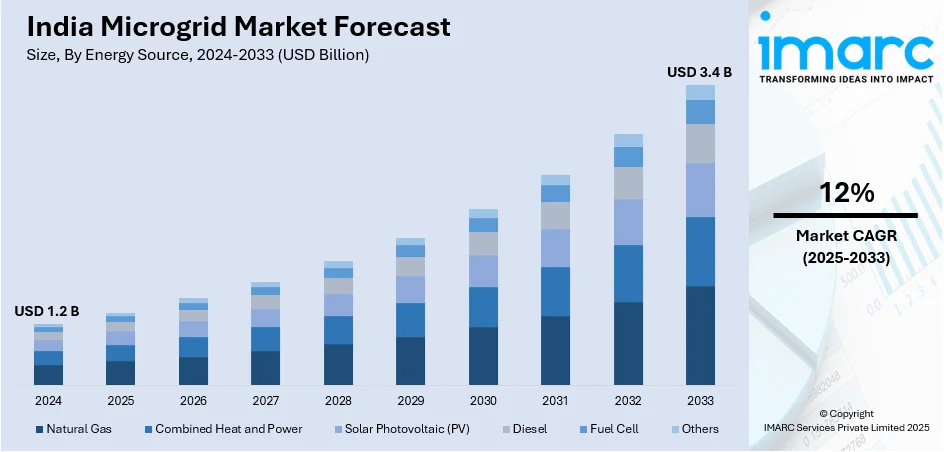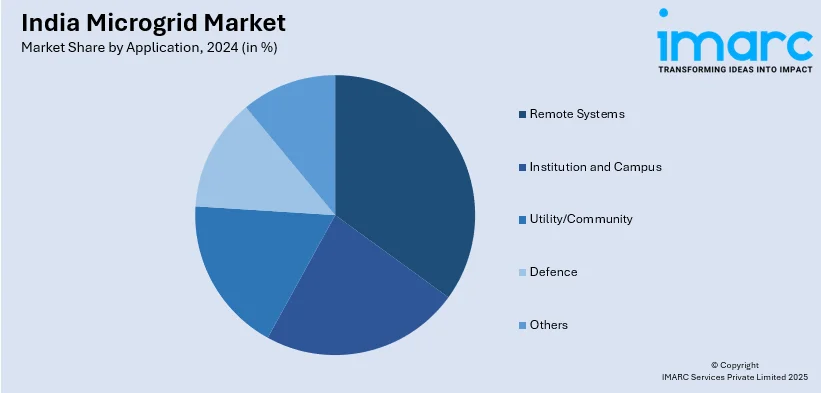
India Microgrid Market Size, Share, Trends and Forecast by Energy Source, Application, and Region, 2025-2033
Market Overview:
India microgrid market size reached USD 1.2 Billion in 2024. Looking forward, IMARC Group expects the market to reach USD 3.4 Billion by 2033, exhibiting a growth rate (CAGR) of 12% during 2025-2033. The increasing advances in energy storage technologies, smart grid solutions, and control systems that have contributed to the increased efficiency and affordability of microgrids, are driving the market.
|
Report Attribute
|
Key Statistics
|
|---|---|
|
Base Year
|
2024 |
|
Forecast Years
|
2025-2033 |
|
Historical Years
|
2019-2024
|
| Market Size in 2024 | USD 1.2 Billion |
| Market Forecast in 2033 | USD 3.4 Billion |
| Market Growth Rate (2025-2033) | 12% |
A microgrid is a localized and self-contained energy system that can generate, store, and distribute electricity independently or in conjunction with the main power grid. It typically consists of a combination of renewable energy sources, such as solar panels, wind turbines, and energy storage systems, along with traditional power sources like generators. Microgrids are designed to operate autonomously or be seamlessly integrated with the larger grid, allowing them to function both on and off-grid as needed. This flexibility enhances energy resilience, reliability, and efficiency, making microgrids particularly valuable in remote or isolated areas, as well as during emergencies or grid outages. Additionally, microgrids contribute to sustainability goals by promoting the use of clean energy sources and reducing reliance on centralized power plants. Their ability to balance supply and demand locally makes them a key player in the evolving landscape of decentralized and sustainable energy systems.

To get more information on this market, Request Sample
India Microgrid Market Trends:
The burgeoning microgrid market in India is being propelled by a confluence of factors, each contributing to its rapid growth and widespread adoption. Firstly, escalating concerns over climate change and the pressing need for sustainable energy solutions have thrust microgrids into the spotlight. Governments in India are increasingly recognizing the pivotal role microgrids play in fostering renewable energy integration and enhancing grid resilience. Moreover, advancements in technology have become instrumental drivers, facilitating the deployment of sophisticated microgrid systems. The integration of smart grid technologies, coupled with the advent of advanced control systems, has empowered microgrids to operate seamlessly, optimizing energy distribution and consumption. Furthermore, the declining costs of renewable energy sources, such as solar and wind, have rendered microgrids economically viable alternatives to traditional centralized power systems. In addition to environmental and technological considerations, the growing demand for energy security and reliability has emerged as a compelling driver for microgrid adoption. Businesses, communities, and critical infrastructure entities are increasingly turning to microgrids as a resilient solution to mitigate the impact of power outages and enhance energy self-sufficiency. In essence, the microgrid market in India is being steered by a convergence of environmental consciousness, technological innovation, and the imperative for reliable and secure energy systems in an era of dynamic energy landscapes.
India Microgrid Market Segmentation:
IMARC Group provides an analysis of the key trends in each segment of the market, along with forecasts at the country level for 2025-2033. Our report has categorized the market based on energy source and application.
Energy Source Insights:
- Natural Gas
- Combined Heat and Power
- Solar Photovoltaic (PV)
- Diesel
- Fuel Cell
- Others
The report has provided a detailed breakup and analysis of the market based on the energy source. This includes natural gas, combined heat and power, solar photovoltaic (PV), diesel, fuel cell, and others.
Application Insights:

- Remote Systems
- Institution and Campus
- Utility/Community
- Defence
- Others
A detailed breakup and analysis of the market based on the application have also been provided in the report. This includes remote systems, institution and campus, utility/community, defence, and others.
Regional Insights:
- North India
- West and Central India
- South India
- East and Northeast India
The report has also provided a comprehensive analysis of all the major regional markets, which include North India, West and Central India, South India, and East and Northeast India.
Competitive Landscape:
The market research report has also provided a comprehensive analysis of the competitive landscape. Competitive analysis such as market structure, key player positioning, top winning strategies, competitive dashboard, and company evaluation quadrant has been covered in the report. Also, detailed profiles of all major companies have been provided.
India Microgrid Market Report Coverage:
| Report Features | Details |
|---|---|
| Base Year of the Analysis | 2024 |
| Historical Period | 2019-2024 |
| Forecast Period | 2025-2033 |
| Units | Billion USD |
| Scope of the Report | Exploration of Historical Trends and Market Outlook, Industry Catalysts and Challenges, Segment-Wise Historical and Future Market Assessment:
|
| Energy Sources Covered | Natural Gas, Combined Heat and Power, Solar Photovoltaic (PV), Diesel, Fuel Cell, Others |
| Applications Covered | Remote Systems, Institution and Campus, Utility/Community, Defence, Others |
| Regions Covered | North India, West and Central India, South India, East and Northeast India |
| Customization Scope | 10% Free Customization |
| Post-Sale Analyst Support | 10-12 Weeks |
| Delivery Format | PDF and Excel through Email (We can also provide the editable version of the report in PPT/Word format on special request) |
Key Benefits for Stakeholders:
- IMARC’s industry report offers a comprehensive quantitative analysis of various market segments, historical and current market trends, market forecasts, and dynamics of the India microgrid market from 2019-2033.
- The research report provides the latest information on the market drivers, challenges, and opportunities in the India microgrid market.
- Porter's five forces analysis assist stakeholders in assessing the impact of new entrants, competitive rivalry, supplier power, buyer power, and the threat of substitution. It helps stakeholders to analyze the level of competition within the India microgrid industry and its attractiveness.
- Competitive landscape allows stakeholders to understand their competitive environment and provides an insight into the current positions of key players in the market.
Key Questions Answered in This Report
The microgrid market in India was valued at USD 1.2 Billion in 2024.
The India microgrid market is projected to exhibit a CAGR of 12% during 2025-2033, reaching a value of USD 3.4 Billion by 2033.
India’s microgrid market is driven by the need for reliable electricity in remote areas, government initiatives promoting clean and decentralized energy, growing interest from industries for stable power supply, and advancements in energy storage and smart grid technologies. These factors collectively encourage the adoption of sustainable and resilient microgrid solutions.
Need more help?
- Speak to our experienced analysts for insights on the current market scenarios.
- Include additional segments and countries to customize the report as per your requirement.
- Gain an unparalleled competitive advantage in your domain by understanding how to utilize the report and positively impacting your operations and revenue.
- For further assistance, please connect with our analysts.
 Request Customization
Request Customization
 Speak to an Analyst
Speak to an Analyst
 Request Brochure
Request Brochure
 Inquire Before Buying
Inquire Before Buying




.webp)




.webp)












